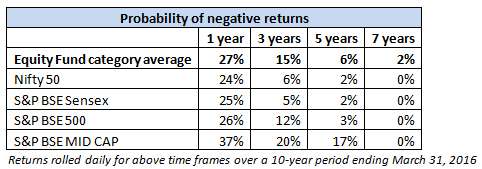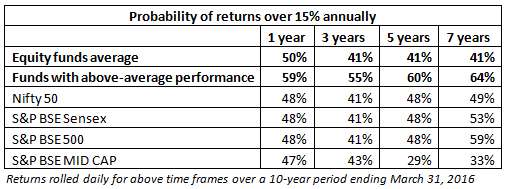Lakshmeenarasimhan S.
Last week, we looked at how indices performed over several time-frames when their returns are tested on a rolling basis over 1,3, 5 and 7-year time frames. You can click here to read the article. This week, let us apply it to real scenarios – that is mutual funds. For this purpose, we took a similar time-frame of 10 years ending March 2016.
Diversified equity funds across market caps as well as tax-saving funds were considered for this purpose. Since we ran it over 10 years, we took only those funds that had a minimum track record of 10 years. This was necessary to see their performance over several time buckets and over longer periods.
The results are below.
The results might startle you a bit. Equity funds have a 2 per cent chance of negative returns over even 7-year time frames! Besides, the probability of negative returns is higher in all the time frames when compared with Nifty, or even with a broad index such as S&P BSE 500.
Why is this so? Are funds performing poorer than indices? Not really. As it is an average, the funds that performed badly skew the picture. Of the 160 funds considered in this analysis, 90 per cent had no instances of negative returns over 7-year time-frames. In fact, close to 60 per cent of the funds reduced the probability of losses to zero within five years itself.
Hence, if we take the median probability (instead of mean), the picture is entirely different:
All the familiar names, be it the Bluechip, Prima or Prima Plus funds from the Franklin stable, or Birla Sun Life Frontline Equity and Top 100, or UTI Equity and UTI Opportunities, to name a few, comfortably passed the above test, both over 5-year and 7-year time frames.
The learning: We can remove the poor funds that skew the averages to see the real performance. But then, you may not have weeded them out from your portfolio.
If you had held these funds and never reviewed their performance, your wealth would have been destroyed even if you held them for the requisite long term. If you are curious to know the name of such under-performers, some of them are: JM Basic, HSBC Midcap Equity, Sahara Taxgain and Escorts Tax Plan. These names might not surprise you today, but you would not have guessed it at the time of investment! Therefore, your effort doesn’t stop with just identifying a fund – you need to ensure that it remains a good performer.
Need to stay with the best
This brings us to the all-important role of an equity fund – which is to build wealth. We know that 5 and 7-year holding periods are the minimum needed. Now consider an annual return of 15 per cent and above (an ambitious figure!).
Using the same rolling return analysis, equity funds delivered returns in excess of 15 per cent less than half the time. The chances of their delivering 15 per cent annual returns, had you invested in any 5-year and 7-year time bucket, was just about 41 per cent of the time. That is, in only four of every ten times would you have made returns of at least 15 per cent. At all other times, your returns would be lower.
Again, apply the performance filter. A good half of the total universe had a probability of delivering 15 per cent-plus returns more than 41 per cent of the time. Considering this universe of funds alone and their average performance, your chances of earning 15 per cent-plus returns improves significantly. In a seven-year time-frame, you have a 64 per cent probability of earning high returns. In a 5-year time-frame, you have a 60 per cent probability of earning 15 per cent-plus returns.
The table below will make the picture simple:
Needless to say, many funds with a long-term track record such as HDFC Equity, HDFC Top 200, Franklin India Prima, Franklin India Prima Plus, IDFC Premier Equity, ICICI Pru Value Discovery, ICICI Pru Dynamic, and tax-saving funds such as Franklin India Taxshield and ICICI Pru Long Term Equity made it to the list of funds with higher probability of delivering 15 per cent annual returns.
Takeaways
The data may seem complex but the takeaways are simple:
– Long-term is necessary in equity funds. But fund choice, staying with the right funds, and course correction when needed is paramount.
– You ought to ‘buy and hold’ equities. However, that does not mean you tolerate long-term underperformers. At the same time, unnecessary churning based on short-term performance would do your portfolio no good.
– Fund choice is not easy. For those who believe equity fund investing can be done in one shot, these results emphasise the need for regular, and process-oriented reviews considering consistency filters such as rolling returns to ensure you are sailing with the right funds.
At FundsIndia, the numbers we crunch are just part of the many other quantitative and in-depth filters we use to ensure your investment goes through minimum shocks and delivers optimal returns. Use our research list of Select funds, our robo advisory, or simply get in touch with our advisors to ensure your investments deliver well.
FundsIndia’s Research team has, to the best of its ability, taken into account various factors – both quantitative measures and qualitative assessments, in an unbiased manner, while choosing the fund(s) mentioned above. However, they carry unknown risks and uncertainties linked to broad markets, as well as analysts’ expectations about future events. They should not, therefore, be the sole basis of investment decisions. To know how to read our weekly fund reviews, please click here.











Good information. I would like to read on small and mid cap funds report in near future
Very good analysis, both the parts.
Quick suggestions (request you not to take it in negative sense, because I work in IT for client presentations, so I always look for continuous improvement):
1. Very similar analysis is presented elsewhere (Pattu’s blog), so you can check what value difference you can bring in compared to other sources. The main objective is conviction, which you achieve with the right data. But it can also be presented in a different way.
2. One good example would be infographics – package your data to ensure it makes right impact, but maintaining neutral view. Another would be giving a different perspective: summarizing some of the text-based data points into comparable table or bullet format. Things like these will add a lot of value and impact to the user.
Hi,
Nice blog. Very useful information as i was for looking for a long term investment plan and equity funds seems to be a good option.
I heard from a friend that equity funds from Principal Mutual Funds is a good investment option.
Hi,
Nice blog. Very useful information as i was for looking for a long term investment plan and equity funds seems to be a good option.
I heard from a friend that equity funds from Principal Mutual Funds is a good investment option.
Good information. I would like to read on small and mid cap funds report in near future
Very good analysis, both the parts.
Quick suggestions (request you not to take it in negative sense, because I work in IT for client presentations, so I always look for continuous improvement):
1. Very similar analysis is presented elsewhere (Pattu’s blog), so you can check what value difference you can bring in compared to other sources. The main objective is conviction, which you achieve with the right data. But it can also be presented in a different way.
2. One good example would be infographics – package your data to ensure it makes right impact, but maintaining neutral view. Another would be giving a different perspective: summarizing some of the text-based data points into comparable table or bullet format. Things like these will add a lot of value and impact to the user.